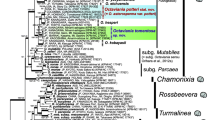Abstract
The genus Porodaedalea is a taxonomically difficult complex of morphologically similar species that inhabit conifers. The evolutionary relationships of European species were examined using sequences of the internal transcribed spacer (ITS) region of the nuclear ribosomal DNA and of translation elongation factor 1 alpha (tefa). Our results confirm the occurrence of Porodaedalea chrysoloma, P. pini and P. laricis in Europe. P. laricis is newly reported in Fennoscandia on Picea and in the Central European mountains (Alps, High Tatras, and Bohemian forest) on Larix and Pinus spp. These specimens had been previously identified as Porodaedalea chrysoloma or Phellinus vorax (an invalidly described species). Although frequently confused, P. chrysoloma and P. laricis can be distinguished on the basis of pore morphology. We also report our finding of P. pini on Larix. In general, the tefa sequences are more variable than the ITS sequences and reveal the remarkable affinity of some Scandinavian and Central European specimens of P. laricis to those from Central Asia. Furthermore, we discovered evidence of interspecific hybridisation between P. pini and P. laricis. In addition, our study revealed the presence of an undescribed species in Morocco. Our results are compared with the results of compatibility tests in this genus that have been published previously.


Similar content being viewed by others
References
Antonín V, Tomšovský M, Sedlák P, Májek T, Jankovský L (2009) Morphological and molecular characterization of the Armillaria cepistipes – A. gallica complex in the Czech Republic and Slovakia. Mycological Progress 8:259–271. doi:10.1007/s11557-009-0597-1
Breitenbach J, Kranzlin F (1986) Fungi of Switzerland, vol 2, Heterobasidiomycetes, Aphyllophorales, Gasteromycetes. Mykologia, Lucerne
Černý A (1985) Taxonomic study in the Phellinus pini group. Čes Mykol 39:71–84
Černý A (1989) Parazitické dřevokazné houby [Parasitic wood-decaying fungi]. Státní zemědělské nakladatelství, Praha
Dai YC (1999) Phellinus sensu lato (Aphyllophorales, Hymenochaetaceae) in East Asia. Acta Bot Fenn 166:1–115
Fiasson JL, Niemelä T (1984) The Hymenochaetales: a revision of the European poroid taxa. Karstenia 24:14–28
Fischer M (1994) Pairing tests in the Phellinus pini group. Mycologia 86:524–539
Fischer M (1996) Molecular and microscopical studies in the Phellinus pini group. Mycologia 88:230–238
Fischer M (2000) Porodaedalea (Phellinus pini group, Basidiomycetes) in Europe: a new species on Larix sibirica, P. niemelaei. Karstenia 40:43–48
Gardes M, Bruns TD (1993) ITS primers with enhanced specificity for basidiomycetes-application to the identification of mycorrhizae and rusts. Mol Ecol 2:113–118
Hall TA (1999) BioEdit: a user-friendly biological sequence alignment editor and analysis program for Windows 95/98/NT. Nucleic Acids Symp Ser 41:95–98
Jahn H (1963) Mitteleuropäische Porlingen (Polyporaceae s. lato) und ihr Vorkommen in Westfalen. Westf Pilzbr 4:91–112
Jahn H (1967) Die resupinaten Phellinus-Arten in Mitteleuropa. Westf Pilzbr 6:37–124
Kauserud H, Schumacher T (2001) Outcrossing or inbreeding: DNA Markers provide evidence for type of reproductive mode in Phellinus nigrolimitatus (Basidiomycota). Mycol Res 105:676–683
Kauserud H, Hofton TH, Saetre GP (2007) Pronounced ecological separation between two closely related lineages of the polyporous fungus Gloeoporus taxicola. Mycol Res 111:778–786. doi:10.1016/j.mycres.2007.03.005
Kotlaba F (1984) Zeměpisné rozšíření a ekologie chorošů (Polyporales s.l.) v Československu [Geographical distribution and ecology of polypores (Polyporales s.l.) in Czechoslovakia]. Academia, Praha
Lannenpaa A, Aakala T, Kauhanen H, Kuuluvainen T (2008) Tree mortality agents in pristine Norway spruce forests in northern Fennoscandia. Silva Fenn 42:151–163
Larsen MJ (2000) Phellinus gilbertsonii sp. nov. from western North America causing heart-rot of coastal Douglas-fir. Folia Cryptogam Est 37:51–54
Larsen MJ, Stenlid J (1999) Neotypification of Phellinus chrysoloma. Folia Cryptogam Est 34:9–13
Niemelä T, Kinnunen J, Larsson KH, Schigel DS, Larsson E (2005) Genus revisions and new combination of some North European polypores. Karstenia 45:75–80
Núnez M, Ryvarden L (2000) East Asian polypores, vol 1. Synopsis fungorum 13. Fungiflora, Oslo
Nylander JAA (2004) MrModeltest v2. Evolutionary Biology Centre, Uppsala
O'Donnell K, Kistler HC, Cigelnik E, Ploetz RC (1998) Multiple evolutionary origins of the fungus causing Panama disease of banana: concordant evidence from nuclear and mitochondrial gene genealogies. Proc Natl Acad Sci U S A 95:2044–2049
Ota Y, Hattori T (2008) Relationships among three Japanese Laetiporus taxa based on phylogenetic analysis and incompatibility tests. Mycoscience 49:168–177. doi:10.1007/s10267-007-0403-3
Paoletti M, Buck KW, Brasier CM (2006) Selective acquisition of novel mating type and vegetative incompatibility genes via interspecies gene transfer in the globally invading eukaryote Ophiostoma novo-ulmi. Mol Ecol 15:249–262. doi:10.1111/j.1365-294X.2005.02728.x
Parmasto E, Parmasto I (2001) Phellinus baumii and related species of the Ph. linteus group (Hymenochaetaceae, Hymenomycetes). Folia Cryptogam Est 38:53–61
Ronquist F, Huelsenbeck JP (2003) Mr. Bayes 3: Bayesian phylogenetic inference under mixed models. Bioinformatics 19:1572–1574
Ryvarden L, Gilbertson RL (1994) European polypores, vol 2. Synopsis Fungorum 6. Fungiflora, Oslo
Swofford DL (2003) PAUP* Phylogenetic Analysis Using Parsimony 4.0. Version Beta 10. Sinauer Associates, Sunderland
Taylor JW, Jacobson DJ, Kroken S, Kasuga T, Geiser DM, Hibbett DS, Fisher MC (2000) Phylogenetic species recognition and species concepts in fungi. Fungal Genet Biol 31:21–32. doi:10.1006/fgbi.2000.1228
Tomšovský M (2002) The genus Phellinus in the Šumava Mts. Czech Mycol 54:45–78
Tomšovský M, Kolařík M, Pažoutová S, Homolka L (2006) Molecular phylogeny of European Trametes (Basidiomycetes, Polyporales) species based on LSU and ITS (nrDNA) sequences. Nova Hedwig 82:269–280
Wagner T, Fischer M (2002) Proceedings towards a natural classification of the worldwide taxa Phellinus s.l. and Inonotus s.l., and phylogenetic relationships of allied genera. Mycologia 94:998–1016
White TJ, Bruns TD, Lee SB, Taylor JW (1990) Amplification and direct sequencing of fungal ribosomal RNA genes for phylogenetics. Academic Press, New York
Acknowledgements
This work was supported by the Czech Science Foundation, project no. 521/07/J039.
The authors are grateful to P. Vampola (Jihlava, Czech Republic) for providing his collections to our study. J. Holec (Prague, Czech Republic), L. Homolka (Prague), T. Niemelä (Helsinki, Finland), S. Ryman (Uppsala, Sweden), A. Kollom (Tartu, Estonia) are thanked for loaning their herbarium specimens or cultures for the study.
Author information
Authors and Affiliations
Corresponding author
Rights and permissions
About this article
Cite this article
Tomšovský, M., Sedlák, P. & Jankovský, L. Species recognition and phylogenetic relationships of European Porodaedalea (Basidiomycota, Hymenochaetales). Mycol Progress 9, 225–233 (2010). https://doi.org/10.1007/s11557-009-0628-y
Received:
Revised:
Accepted:
Published:
Issue Date:
DOI: https://doi.org/10.1007/s11557-009-0628-y




